WWII US Navy China by Officer Rank Insignia Topmark

Click Photo for Close Up View!

Click Photo For Close Up View!



 Of Special Note - Antique Naval China Substantiates Inception and History of the Department of the Navy Seal: The Pirate's Lair has now obtained concrete prima-facie evidence of the very first standardized US Navy Department of Navy Seal ever issued and dated as early as 1894 and used through 1908.
Of Special Note - Antique Naval China Substantiates Inception and History of the Department of the Navy Seal: The Pirate's Lair has now obtained concrete prima-facie evidence of the very first standardized US Navy Department of Navy Seal ever issued and dated as early as 1894 and used through 1908.
Please excuse both syntax and grammar as this page is also designed for the Search Engines
Prior to the late 19th Century there appears to be only miminal consistency and limited selections to the type of Navy Dinnerware and Navy Tableware used by both enlisted and officer alike. Though functional with a Naval flair, the selection and grade of dinnerware used by sailors and officers left alot to be desired and consisted mostly of enamelware porcelain plates, bowls and cups!
Additionally, there does not appear to be much of any official Naval history or documentation (anecdotal or otherwise) of what either the enlisted crew or officers used in the way of dining utensils or tableware up until the early 1890's and very early 1900's.
However, through old photographs obtained by The Pirate's Lair of sailors eating on their respective mess decks, wardrooms and galleys it appears that the white to off-white tin covered enamelware metal plates, bowls and cups incorporating "USN" or "US Navy" were pretty much standard from post Civil War up until the early 1900's. Though this enamelware used as standard Navy dinnerware and Navy tableware was sturdy and utilitarian to hold up to salty seas and repetitive heavy industrial cleanings, it certainly was not made for elegant fine dining.


The photo to the left is of a US Navy enlisted porcelain covered tin metal plate (enamelware) ca 1880's to early 1900's and the photo to the right is a matching enamelware bowl or cup. There is also a matching enamelware cup similar in size to the bowl, but the cup has a metal holding tab with a hole in it and soldered onto the lip. This tab appears to have allowed the cups (or bowls) to be stacked onto a long rod for storage and use.

For a more in-depth photo historical analysis and provenance of this 1890s to early 1900s, SpanAm War and Great White Fleet Era enlisted enamel dinnerware Click Here
To the left is the standard regulation issue enamelware plate and bowl put together either by the sailor in the photo or his family in commemorating his naval service. Note the dates May 1903 to May 1907 which was the typical 4 year naval enlistement. This commemoration is on permanent display at The Pirates Lair.
It is believed that this was the type of plate along with similarly produced and marked cups and bowls were used by both enlisted crewmen and perhaps junior officers. Quite possibly this type of enamelware was even used by enlisted sailors well into the early 20th century during the voyage of the Great White Fleet and maybe during WWI. We have been fortunate enough to collect quite a number of these plates, bowls and cups.
As can be seen the plate has USN in light blue lettering along it's flat rim with the rim edge being highlighted in a dark blue. All in all a very handsome plain porcelain enamelware plate. We have obtained a number of ca-1890 to 1907 photographs illustrating crews mess decks where this particular enamelware was being used!
These enamelware plates, bowls, cups and other antique naval dinnerware can be purchased by Clicking Here.

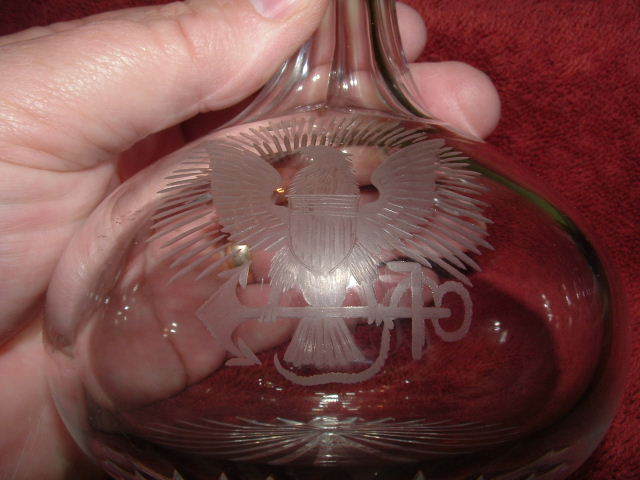
Note that the Eagle Clutching Anchor insignia on the above crystal decanter is the exact same as seen on the demitasse cup at the top of the page. This kind of prima facie evidence is used to help date and validate the various patterns of naval dinnerware. Also, this 1890s-1910 "Eagle Clutching Anchor" insignia or topmark was the forerunner of todays "Department of the Navy" seal which was first put into use ca 1905.


Note that the "Department of the Navy" seal shown on the above decanter was first established ca-1905 as identified on various pieces of china plates and cups. There is almost no difference between the current Department of the Navy seal used today and the one first established ca 1905. The only difference is that the earlier seal had "rays" emanating above and below the eagles wings, whereas the current seal only has them above. This change was made about 1940.
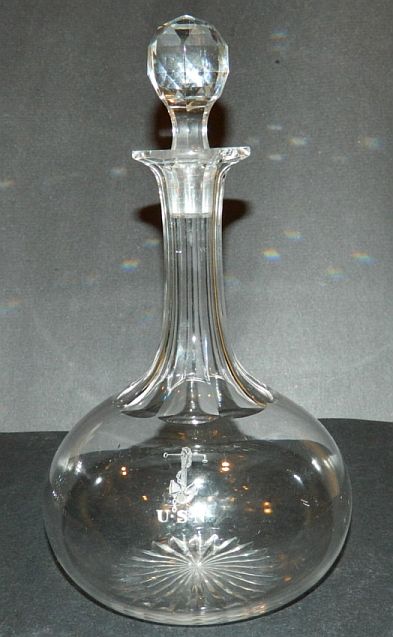
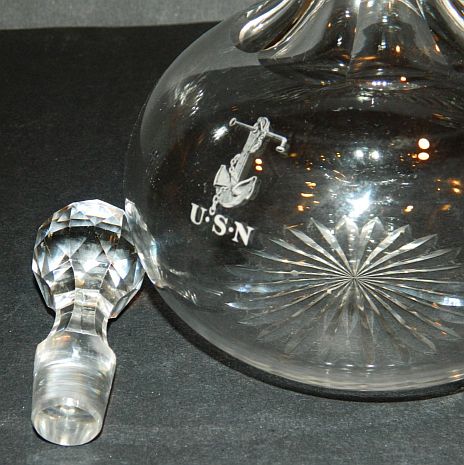
US Navy Crystalware and Stemware is Handsomely Elegant and Can Tell a Story! The "Twisted Arm Fouled Anchor" in gold leaf was first seen on US Navy china as a topmark on/about 1905.
Late 19th and very early 20th century official US Navy insignia can be found on the above 3 lead crystal decanters. The top two show the 1894 Eagle clutching the fouled anchor with the initials USN engraved on the rear. The middle two photos illustrate the early 1905 Department of Navy Seal incorporating the Eagle clutching the Fouled Anchor and initials USN. The last two photos show another early 1905 decanter illustrating the Fouled Anchor by itself along with the intitials USN.
Just prior to the turn of the 20th Century (in the late 1880's to be exact), it appears that the United States Government was about to embark on a major entrance into World Affairs and was appropriately going to use the US Navy to do it by transporting our diplomats and dignitaries to wave the flag! Part of this plan was to build a great armada of first line dreadnaughts including armored cruisers, battleships and other supporting vessels to be used in what was termed our "Great White Fleet" which sailed around the world from 1907 to 1909. This was to be a first for any global circumnavigation by an all-steam all-steel major fleet or armada.
The United States government in it's preparation for entrance onto the world's political stage at the end of the 19th century realized that if our "first-class top-of-the-line" first-ever all-steam all-steel Navy Fleet which was then being built to circumnavigate the world (while waving our flag and transporting our diplomats), the Navy also needed to have "world class" second-to-none Naval Dinnerware and Naval Tableware along with appropriate manners and customs so as to entertain Kings, Queens, Emperors, Presidents, other Heads of State and Diplomats. We have documented much of the Naval History of silverware and flatware used by the US Navy from the 1890's through the 1970's and this can be reviewed by Clicking Here.)
These antique lead crystal US Navy Decanters and other antique naval dinnerware can be purchased by Clicking Here.
Suffice it to say that before the turn of the 20th Century the United States was not much interested in what was happening geo-politically around the world and nor could it after our devastating Civil War. We did not necessarilly pay much attention to some of the finer or more refined aspects of what our sailors ate from. We have to keep in mind that in the 1860 to 1890's the United States was either in a Civil War or in a major reconstruction and consolidation effort.
So our focus in the late 1870's to the 1890's was all about rebuilding the country's basic infrastructure. During this reconstruction period we are quite sure that individual Captains and Admirals of our ships and fleets each had their own exquisite personal china and tableware which they used for everyday and on formal occasions. However we have not been able to identify any official US Navy-issued "fine dining" tableware prior to 1894.
A "demitasse cup" as illustrated below in this page is the earliest piece of Official Navy-issue China Dinnerware we have ever found, and it is dated 1894. The next piece with the same Navy Seal is a "fish server" which is by the same manufacturers and is dated 1898. We have also obtained photographs of a "soup bowl" using the same Navy Seal and it is dated "1898" as well. (see below)


Above are two photographs of an 8" long bottle used to hold pepper sauce by sailors during the Civil War. One side has the raised word PEPPER and on the opposite side U.S. NAVY. There was also a similar bottle with MUSTARD on one side instead of pepper.
It is unclear whether each crewmember had their own bottle of pepper sauce or whether it was part of the general galley or mess decks and shared by all. Also, this bottle did not contain the same type of dry pepper we are used to today, it was a pepper sauce. The bottle stopper was made out of cork. This is an original bottle and was used during the Civil War and found in Georgia.


Above two photographs are of a razor sharp, beautifully produced 14.5" long butcher knife with a 9" blade and rose wood handle made by the famous cutlery manufacturer Lamson & Goodnow Manufacturing Co for the U.S. Navy. Note the eagle with outspread wings and the fouled anchor which are both representative of similar designs used by the US Navy during the very late 1800's to very early 1900's which is when this knife was made.
Lamson & Goodnow were the premier quality American cutlery producers from the mid/late 1870's and even up to today! However their sole claim to the high-end market was just before and after the turn of the 20th century and rivaled all of their European competitors. No wonder the US Navy and US Marine Corps standardized all of their cutlery using L&G products.
We also have a very similar and rare butcher or carving knife also by Lamson & Goodnow which was made specifically for the US Marine Corp ca 1880 to very early 1900's that has the scripted calligraphy and stylized letters U.S.M.C. engraved on the blade above the L&G logo.

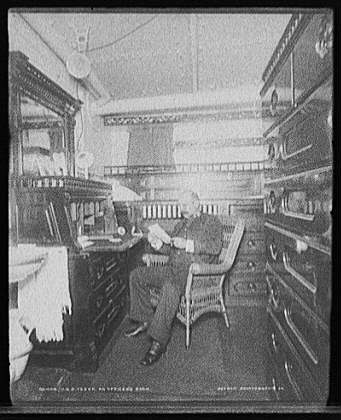
To the left is a late 19th Century and early 20th Century Amphora-like Water Pitcher used in Captains Cabin, Officer's Staterooms and possibly even in Enlisted Shower/Bathroom or Berthing areas as well. Perhaps even on the Mess Decks to safely hold water. This amphora-like water pitcher sits in a circular steel floor mounted swivel for ease of use and to prevent spillage during high seas and rough weather conditions.
The Pirate's Lair has the exact same U.S.N. matching pieces in white porcelain soap dishes, sinks, and water washbasins which were used aboard ship in the 1860's and early 1900's.
The Photograph above right illustrates the Water Pitcher and Water Basin being (very far left in photo) as used in the Captain's Quarters Aboard the USS Texas Ca 1907.
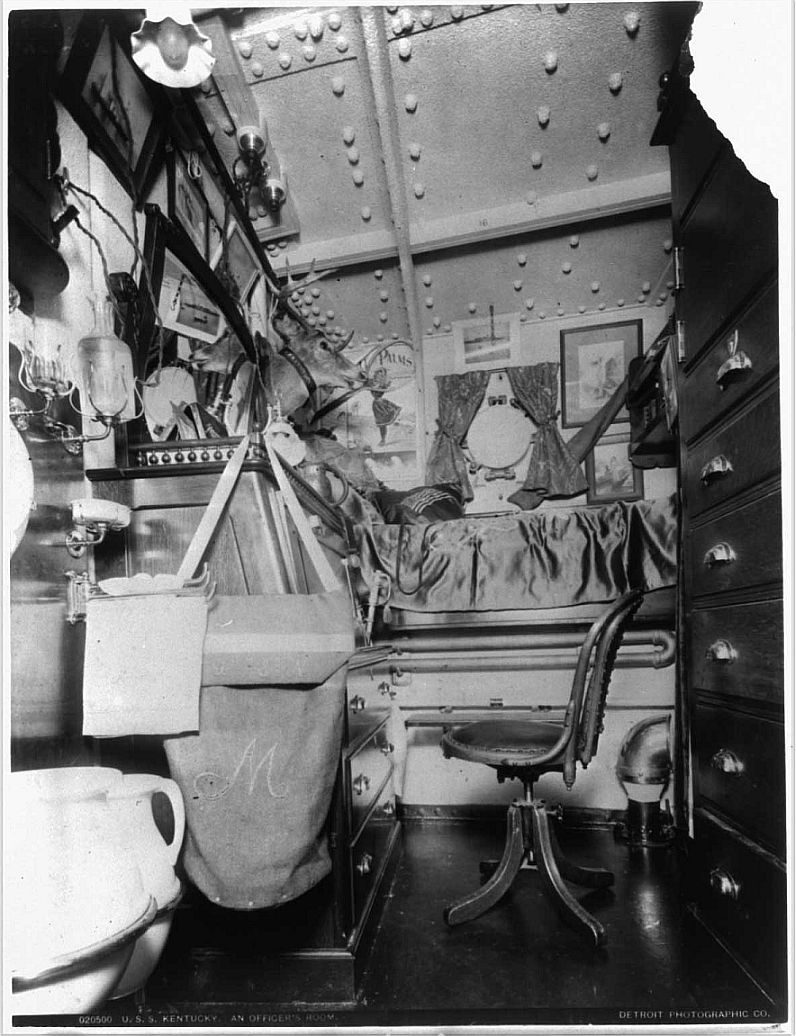
Above photo shows an officers stateroom aboard the USS Kentucky ca-1898 where the hygieneware of porcelain water pitcher, slop bucket, and soap dishes are clearly shown to the left in the photo. Note the steel circular holding rings for the jars and wall bracket used for the soap dish.
Again, very similar arrangement of slop jars, sinks, soap dishes as found in the period photograph of the Captains Cabin aboard the USS Texas. This establishes a standardization of sorts on how the bathrooms or "heads" of staterooms were outfitted and organzied.
(Below you will find a photograph of the restored stateroom of the Ironclad USS Monitor in which a washbasin is shown just like the one here on the USS Texas and what The Pirate's Lair has in its collection.)
Additionally both the water basin and pitcher are placed in round circular steel rings attached to the wall while the pitcher is placed in a steel ring which is floor mounted and allows the pitcher to be tilted to dispense the water.

The above photographs illustrate a "waste water slop jar" which was used in an officers stateroom for personal hygiene prior to the advent of indoor plumbing aboard US Navy ships. This is a matching piece to the water pitcher, sink and basin, water tumbler, and soap dish also found on this page. Note the porcelain ring around the pot (similar to the water pitcher) which allowed it to be placed in a metal ring that would be attached to the deck of the ship. A waste water slop jar is available for purchase and can be found by Clicking Here - US Navy Civil War Soap Box.
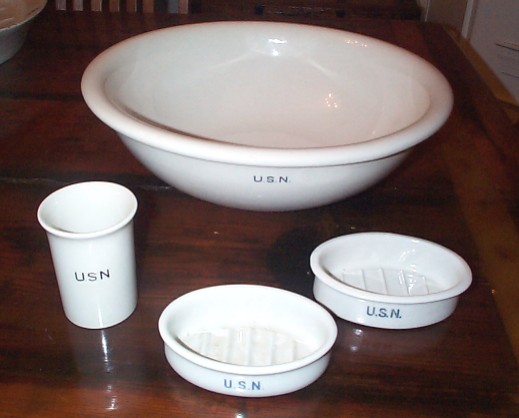
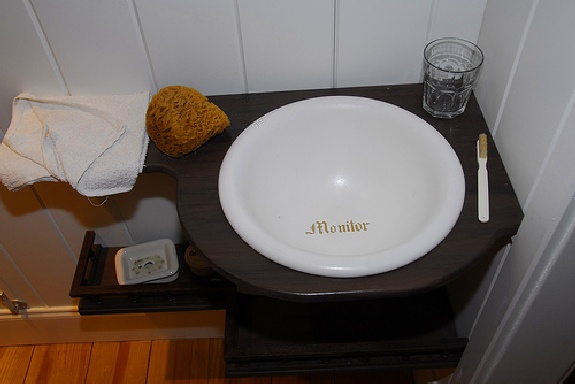
The photo to left consists of a collection of personal hygiene porcelain items (called sanitaryware or hygieneware) circa 1860's to very late 1880's consisting of a water washbasin, two soap dishes with standardized univeral mounting brackets and a matching water tumbler also having a standardized metal wire mounting bracket.
The photo to the right shows the restored officer's stateroom aboard the ironclad USS Monitor of Civil War fame. Note the similarity between the washbasin used in the Monitor and the washbasin shown to the left, exactly the same! Also shown is what appears to be a metal soap box with an anchor in the lid.
While this soap box may be a period piece and perhaps even found on the Monitor when she was being restored, there was also a soap box for shaving specifically made during the Civil War for the US Navy.
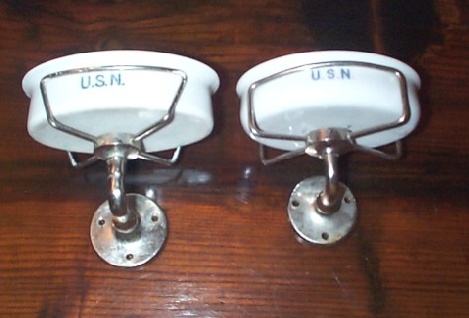
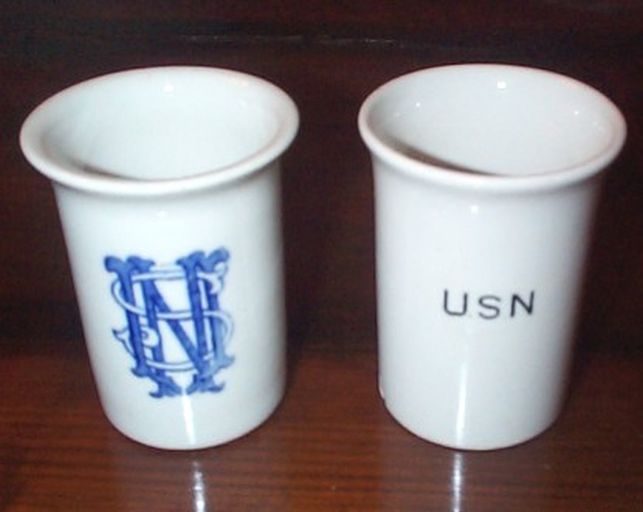
The photo to the left shows the two soap dishes with their corresponding brackets shows how easily the soap dishes could just be popped out and removed from the mounting brackets allowing each sailor to have their own soap and soap dish. It has been verified through photographic evidence that these items with the stylized and plain U.S.N. topmarks were used in the 1860's to the 1890's.
The above photo right photo shows two personal hygiene water tumblers for the head or bathroom with the fancy stylized USN insignia both tumblers are fairly close in design and would have fit into the same metal wire bracket holder. One is fairly plain while the other is very fancy and stylized, but both could fit into a standard or universal wall holder bracket, similar to what is used on the matching soap dish.
Both the plain and stylized USN marked soap dishes, tumblers, sinks and wash basin, water pitchers and shaving mugs (and corresponding mounting brackets) were universally made Navy-wide so that each item could fit into a standardized universal mounting bracket no matter what ship the crew member took his personal items to during a transfer.
As can be seen all of these items including the above water pitcher all have the same U.S.N insignia on them. The manufacturers of these personal hygiene or sanitary ware items were made by various producers including among others the Standard (later called American Standard),Jones, McDuffee & Stratton of Boston, and The Trenton Potteries Company. It is believed that the hygiene ware with the USN insignia were used by enlisted and jr. officers and each crew member had there own personal soap dish and water tumbler which they just placed into the mounting brackets when being used in a community bathroom or head.
Other than enamel-on-metal (enamelware or porcelainware) cups, plates and bowls with the simple USN monogram we have no evidence of any china dinnerware or tableware which consisting of the plain U.S.N. insignia on any plates, bowls or cups. This lack of finding any corresponding dinnerware leaves us with the impression that the plain USN insiginia found on the personal hygiene ware soap dishes, water tumblers, water basins and sinks were possibly used just by junior and wardroom officers.
Obviously senior officers such as captains and admirals as shown in the above photograph had their own private bathrooms and washing areas. More detailed photos and review of Naval Sanitaryware or Hygieneware can be found by Clicking Here - US Navy Simple USN Monogram on Sanitaryware/Hygieneware.
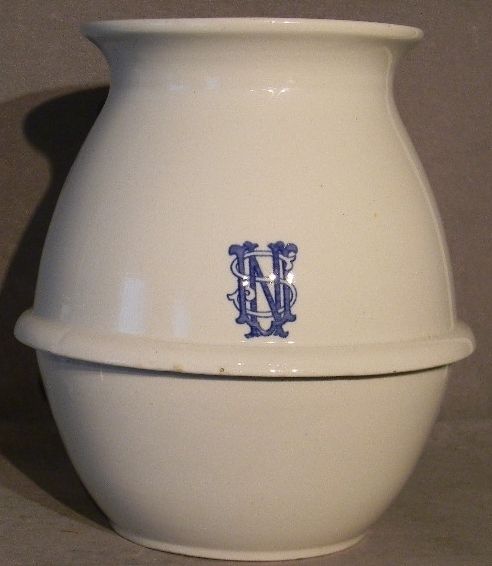
Photo to the left is another waste water slop jar with the stylized monogram "USN" favored ca 1860s and post-Civil War and is currently in the collection of The Pirates Lair. We have 3 such jars, 2 with a plain USN monogram and 1 stylized.
It appears that both the plain and stylized initialed ceramic or porcelain hygieneware coexisted about the same time. Quite possibly the nicer stylized items were used in a senior officers stateroom while the plainer items were used by lower ranking wardroom officers.
We don't believe that these types of high end items were given to the enlisted crews as period photographs show that they sometimes used metal funnels and wooden buckets instead!
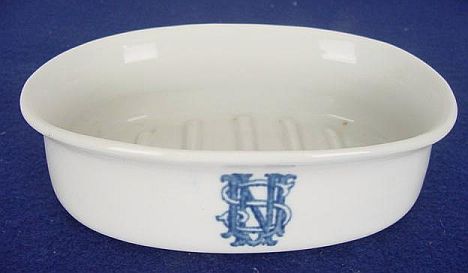
Photo to the left shows another US Navy Soap Dish with the fancy stylized insigina used from the 1860's to late 1890's. Note that this insignia matches the one found on the above tumbler and closely resembling the insiginia found on the below turkey platter. It would also stand to reason that the US Navy also supplied matching sinks and water basins, floor mounted water pitchers and floor mounted slop pots as part of the typical hygieneware for senior officers and commanders.
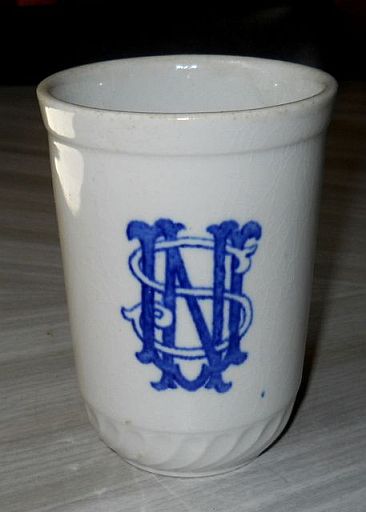

Above are photographs of a rarely found fine china or porcelain large 8" water cup using the stylized "USN" insignia that is actually backstamped with a manufacturer, "J.McD.&S Boston" which was a famous American fine china and porcelain dealer and distributor named "Jones, McDuffee & Stratton" located out of Boston. This company was established in 1871 and discontinued operations in 1966!
This firm was a fine china designer and collaborator (and largest distributor) with Wedgewood China for over 75 years and quite possibly this water cup was made by Wedgewood. However J.McD.&S worked with other china and porcelain manufacturers here in the United States and abroad as well. But the quality, pattern, and style of this water cup made for senior officers of the US Navy bears a distinct resemblence to that produced by Wedgewood in the late 19th century.

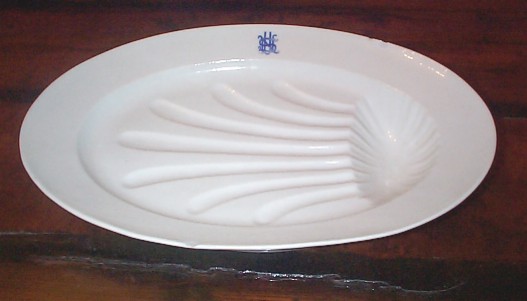
The above two photos to the left and right show both a Civil War era personal hygiene bathroom 6" high water tumbler and a large turkey server or turkey platter with the very fancy stylized USN insignia. We have personally seen fine china dinner and salad plates and soup bowls with the exact same stylized fancy USN insignia topmark on them so we know that an entire standardized dinnerware and tableware set was produced. The date of use for these items we believe are Civil War era and used circa 1860's to very early 1890's.
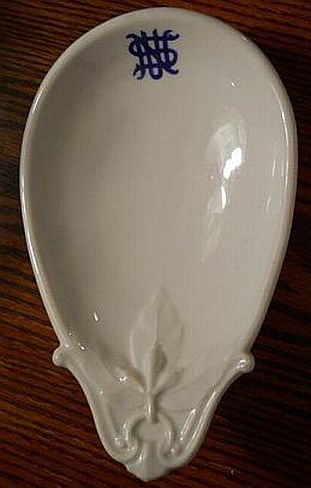
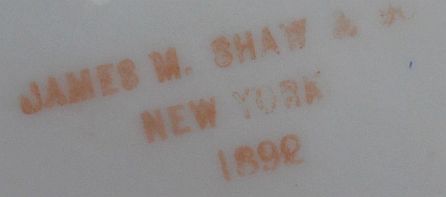
The photos above display a medium size (8.5" x 5.25") Serving or Chafing Dish with the exact same stylized USN as the turkey platter and fortunately it has been bottom marked "James M. Shaw & Co New York 1892". Note that this particular stylized USN monogram isn't as fancy or as pleasing as found on the other USN monogram above.
Now as you have seen from many of the pieces here, the James Shaw Company was very well known and active china distributor in providing fine china dinnerware to the US Navy.
This indicates that by having two serving pieces, turkey server and chafing dish, a much larger and more inclusive set of dinnerware was produced ca 1892 (and earlier) which most likely consisted of plates, cups, saucers, bowls etc etc.
However this particular pattern and topmark has been seen and used on many non-dinnerware pieces of Civil War era Union Navy equipment such as boat bumbpers, sinks, basins, water goblets, etc etc so it is safe to say that it was a "standarized" decorative insignia denoting naval ownership from at least the 1860s to 1892.


Above is a heavy and thick 10" serving bowl with footed pedestal bottom showing the more simple though stylized monogram USN as found on the turkey platter and candy or chafing dish. It is backstamped "James M Shaw Co, New York". This certainly solidifies the fact that this was another significant regulation pattern of dinnerware used by the US Navy ca 1890s, and possibly as early as the 1860s.
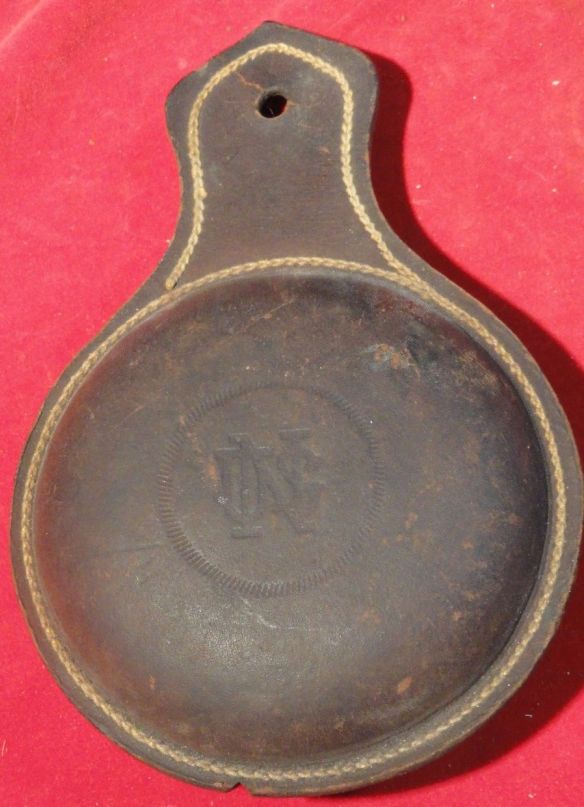

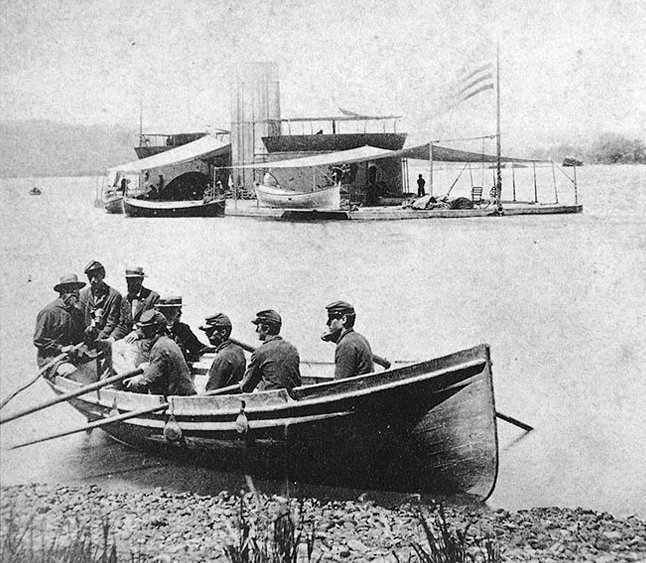
The above photos of a Civil War Union Navy leather docking bumper used aboard small row boats illustrates the stylistic "USN" monogram also found on both naval dinnerware and hygieneware, ca 1860s-1890s! Also note the period photograph of a row boat from the USS Onondaga on the James River and the leather bumpers deployed along the starboard side of the boat! This relatively plain monogram has also been found on a Civil War era Turkey Platter that is in the collection here at The Pirates Lair further attesting to the age and provenance of all of the articles.
Click Here For Further Photo-Historical Information and To Review Items Using the Stylized USN as a Topmark


Photos above and to the left are of a beautiful and finely made porcelain china bowl (8.75" high x 3.75" wide) manufactured by Greenwood China of Trenton, NJ and made "expressly for the U.S. Navy" for the James M. Shaw Co of NY dating this bowl from 1878 to 1930's (most likely post WWI and pre-WWII). This is a very simple yet elegantly made with a single blue stripe along the rim. We have never seen another example of this particular pattern and must assume that it was not a widely used one, and perhaps this was a "sample pattern" submitted to the Navy for evaluation.
It appears that the US Navy began training its Officer Corps in a standardized proper meal etiquette starting in the Naval Academy, quite possibly in earnest during the post-civil war 1880s and certainly in the 1890s as it was building its first all-steel coal-fired fleet.
At about this time the US Navy also contracted with various china manufacturers and their distributors to produce top-of-the-line worldclass china and tableware experimenting with official US Naval insignia "topmarks" to denote the specific rank of the Officer's mess or wardroom.
The formalized Naval insignia (or topmark) found on today's naval china and dinnerware initially consisted of a gold Eagle with a federal shield emblazoned across its breast and clutching a fluked fouled anchor with this pattern lasting from 1894 to 1908. This first official topmark was later transformed into two separate topmarks one consisting of a "fluked anchor with a steel stock" and the second into the "Department of the Navy Seal".
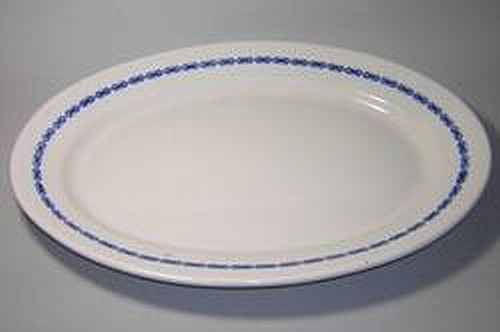
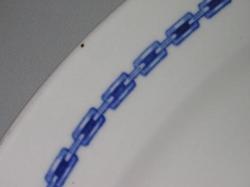
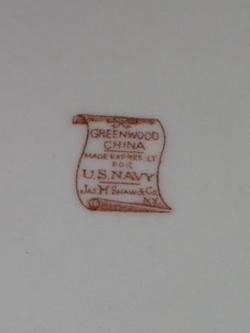
Above are 3 photographs illustrating a US Navy Large Meat Serving Platter (20" x 10") and backstamped "Greenwood China, Made Expressly For the US Navy, Jas. M. Shaw & Co, NY" which is the exact same backstamp as found on the above plain serving bowl. This "Chain Link" pattern is also found on Demitasse Cups and Saucers produced by Buffalo China Company! But besides the large meat platter shown above we have not observed and other china pieces using this "chain link" pattern, and perhaps like the plain bowl shown above this was a one-off or sample pattern made for evaluation purposes by the Navy.

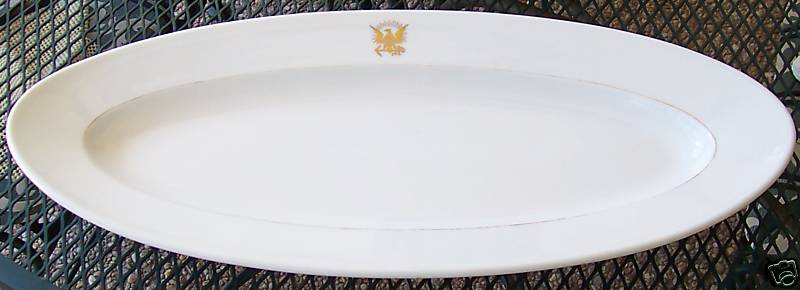
We have evidentiary proof that the Navy began purchasing this elegant china in 1894 and ending in 11908 establishing this pattern and topmark as a single standardized pattern of china whose production which consisted of multiple producers spanning over 14 years of multiple production runs.
This white body with gold eagle and anchor pattern has been found on demitasse cup dated 1894, two dinner plates dated 1894 and 1898, a fish server dated 1898 all produced for the James Shaw Company by T. Haviland & Co. of France. A single dinner plate using this exact same white body with gold eagle and anchor was also found to be made by "O.P.C.O. Syracuse China" with a backstamp dating from 1897.
Recently discovered has been a dinner plate using the exact same topmark of golden eagle clutching fouled anchor made by Haviland of France imported through the James M. Shaw Co of NY with a backstamped date of 1908 (see photos below). So here is firm evidence that this particular topmark was used over a 14 year period.


The above photos illustrate two serving pieces (hard candy dish or receiving plate and a lead crystal decanter) both of which further reinforces the indication that this was a significant topmark insignia
Also Note that in the photo image of the US Navy China Demitasse Cup with a topmark illustrating an Eagle with Federal Banner clutching a Fouled Anchor with Stripe Highlights above the Eagle with feathery stripes or highlights extending out from below the Eagles wings. Also, the Eagle has a Federal Banner across it's breast. There are also 2 Stars shown to the left and right of the Eagle which could have represented the Atlantic and Pacific Oceans OR the rank of 2 Star Rear Admiral.
(The current Department of Navy Seal adopted about 1905/1906 has two stars as part of the Seal, however these have been designated to be the Atlantic and Pacific Oceans.)
We believe that this is evidence of the very first official "Navy Seal" which was the forerunner and basis for the later designed Department of the Navy Seal established pre-WWI in the early 1900's! With some very slight modifications made on/about 1941 it is still being used today over 100 years later! Something to be said for Naval Customs and Tradition!
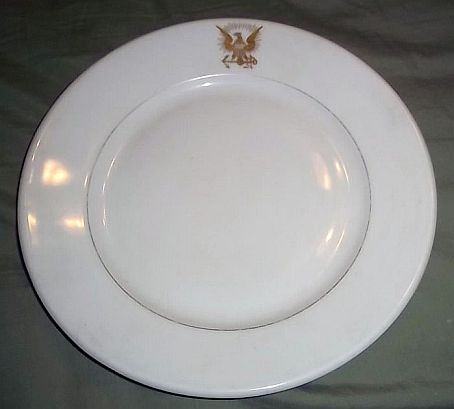
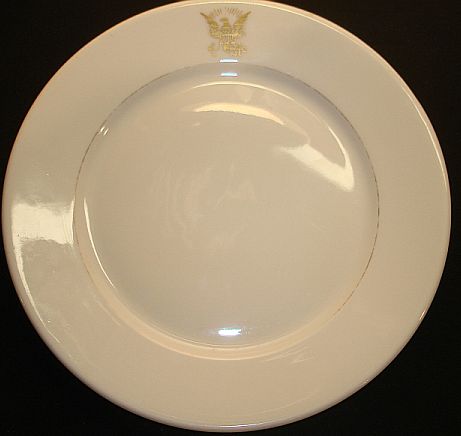
Show above are two dinner plates with backstamped dates of 1894 and 1908 respectively by two different manufacturers showing absolute verifiable proof that this was indeed a signifcant topmark insignia standardized by the US Navy for use in its Officers Wardroom and Mess.
Click Here for Futher Review and Photo-Historical Documentation of the "Gold Eagle Clutching Fouled Anchor" topmark.
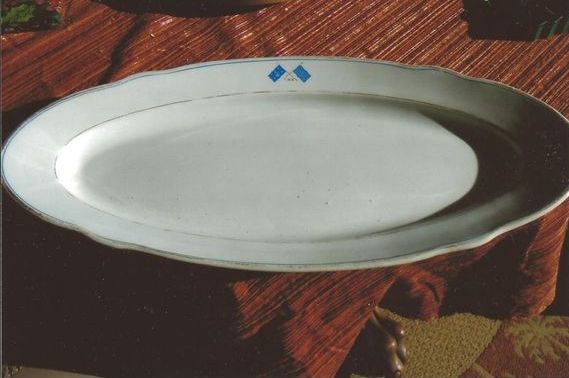

Above you will find a "one off" of sorts. This is another huge fish serving platter (22" x 10") which was part of the service used by The Secretary of the Navy ca 1890s to 1907.
In determining the provenance of this piece note the 4 Star Flag with Fouled Anchor to the left and the blue field Union Jack with 45 white stars to the right, along with the initials USN placed between. The 4 Star Flag with Anchor as depicted is the official flag used by The Secretary of the Navy, and the Union Jack showing 45 stars, one star for each state in the union, is very significant in establishing the date the fish server was in use and who the Secretary of the Navy was at that time.

Note the pedestalled fruit or pastry bowl to the left which has the exact same pattern as the fish server, however it is manufactured by Theodore Haviland of Limoges, France. Click Here for more photographs and analysis regarding this rare and historically significant pedastalled fruit or pastry server.
The Union Jack only had 45 Stars from 1896 thru 1907 as each star in the Union Jack represents a state. In 1896 Utah was added as the 45th state in the Union and an additional star was then added to the national flag and the union jack for a total of 45 stars. This number of states and stars remained the same for 12 years when in 1907 Oklahoma joined the Union as the 46th state, Click Here to Review List of States as Entered by Date into the Union).
Fish Server was manufactured between the 1890's and 1911. The fish server has an imprinted manufacturers backstamp located on the bottom of the piece with a capital "M" above the word "CHINA" which itself is above a capital "L". This was the backstamp or bottom mark used by the Maddock Lamberton China Company ca 1890's-1911! This backstamp has been adequately date documented and can be seen in Barbara Conway's authoritive "Restaurant China Identification Guide, Volume 2".
So from the evidence we can establish that this fish server was part of a much larger dinnerware service used by a Secretary of the Navy and based upon the Union Jack and manufacturers backstamp was produced ca 1896 to 1907 and used by Secretaries of the Navy even after that date until a new pattern was approved.
Through research it has been determined that during the period in question, 1896 thru 1907 there were six appointed Navy Secretarys so it is nigh impossible to determine which specific secretary had purchased or used this service.
However it is reasonable to assume that since this china service was made for the Office and not the individual that it was actually used by a number of different Secretary's well into the early 1900s. Click Here To Review List of Secretarys of the Navy Additionally, yet only anecdotal, the initials USN shown being used on the fish server are in the older pre-WWI font and style.
Click Here for more photographs and analysis regarding this rare and historically significant fish server.

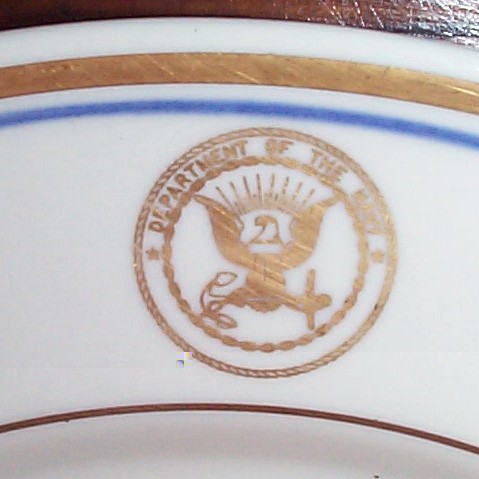
Navy Seal to the Left is ca 1905/1906 to 1939 and the Navy Seal to the Right is Ca 1940 to Present Day
The above Department of the Navy Seals are both very similar with each using two concentric circles (inner circle of chain, outer circle of rope) with Department of the Navy sandwiched within them with two stars. However the topmark on the left was used from about 1905/1906 through 1939, while the one on the right was used from 1940 through to present day.
The differences between these two topmarks while slight clearly shows the topmark on the left having gold stripe highlights below the wings of the Eagle, the Federal Shield clearly emblazoned over the Eagle's breast, and the differences between the Fouled Anchor's which the Eagle is clutching.
The Navy Seal on left has the earlier original version that included gold stripes below the eagle's wings, had an "open" Federal Shield clearly showing a blank top field and vertical stripes, and the Fouled Anchor used was a Twisted Steel Stock which was used on the earlier 1894 and 1894 topmarks.
The Navy Seal on the right eliminated the gold stripes below the wings, made the Federal Shield "solid" almost being unseen over the body of the Eagle, and the Fouled Anchor now had a Straight Wooden Stock. This particular version of the Seal was used from 1940 through the 1970's.


The above two candy dishes which were also widely used as receiving (reception) plates or calling plates for personal cards illustrate the original and older Department of Navy Seal approved ca 1905. This particular seal was standardized and used on all china reserved for senior officer's and was part of the Great White Fleet effort in not only showing the world our military might but also that we knew how to dine in style, had manners,
and were no longer the uncouth backwater "colonialists" which is how much of the world still viewed us.
However each of these pieces also have a manufacturer's date code on the bottom indicating 1909 production, so as to provide us with a specific date of manufacture which helps to date the topmark. Note that both use the pre-WWII Department of the Navy Seal on the left showing 2 Stars denoted that this was used by a Rear Admiral.
The 10" Square Plate is dated 9/09 representing September 1909 and was made by The Shenango China Co for L. Barth & Sons of NY which is glazed on the bottom of the piece. Barth & Son was a well known china distributor who apparently used Shenango to actually make this square candy dish. Obviously Barth received a Government Contract for this candy dish and they had Shenango produce it.
Of even further rarity is that "Shenango China, New Castle, PA" is actually imprinted right into the clay which is rarely seen. Additionally, the Department of the Navy Seal has two stars to the left and right denoting a 2 Star or Rear Admiral. So, this particular plate was made in 1909 to be used by a 2 Star Rear Admiral.
The 8.5" Oblong Plate is actually dated 1918 and was made by Mayer China for the James A. Shaw & Co of NY. Again, we can easily surmise that it was the Shaw Company who was a knonwn china distributor which received a Government Contract to provide the Navy with Oblong Candy Dishes. Shaw happened to use Mayer China to produce this piece.
The Pirate's Lair actually has a number of these Oblong and Squarish Candy Dishes, (Receiving or Reception Plates) which are virtually identical to each other but all having different date codes! The first Oblong Dish is by James A. Shaw while the second one is bottom marked as being produced by Shenango with a 10-18 date code! We can readily see that standardizing on both a topmark design and a china pattern certainly helped the Navy to achieve competition from two different
manufacturer's while also getting tableware which could sit side by side virtually indistinguishable from each other.
These antique candy dishes, receiving plates, serving bowls, and other antique naval dinnerware can be purchased by Clicking Here.


The above two photographs illustrate another square candy dish or reception plate (dated 10/06 or October, 1906) which is in blemish-free museum quality condition using the newly designed and approved Department of Navy Seal. This receiving plate or candy dish was actually manufactured by the Shenango Pottery Company (barely visible imprint into the china) who in turn made it for the Greenwood China company,
who in turn it for the James M. Shaw Company of New York, who in turn had it "expressly produced" under contract for the U.S. Navy!!
The decanter to the right illustrates the 1905 Department of Navy Seal with similar highlights emanating from the feathers of the eagle.

This is the absolute earliest documented use of the Navy Seal as it is used today, over 100 years old! This and some of the other plates in our collection were most certainly used aboard at least one of the vessels which sailed with the Great White Fleet of 1908 in that they were obtained along with documents and photos of a sailor who was on that around the world voyage!
We have another square candy dish or reception plate identical to the two shown above but made by the Lamberton China Co for the Higgins & Seiter Co of NY and is dated November 1905. Having the same candy dishes or reception plates "expressly produced" by various manufacturer's certainly proves that the US Navy not only standardized the shown Navy Seal but also to very strict specifications for the types of china pieces it was purchasing, and obviously purchasing them in a big way.
All of these early produced china pieces were hand glazed which makes them very collectible within the antique china market. (The Department of Navy Seal appears to have been made from a hand glazed stencil, while the gold and white body were hand painted or glazed). But made "Expressly for the U.S. Navy" makes them significantly more rare and valuable.
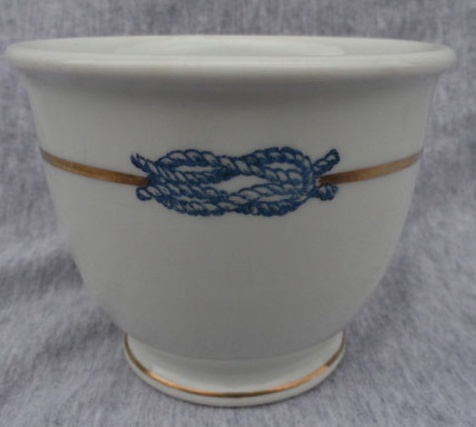
The footed egg cup to the left is quite unusual and as far as we know is the only example of this particular pattern of topmark. Quite possibly this topmark is an "orphan" meaning that it was only briefly made, possibly for a particular or singular purpose, and did not become a standard Navy-wide insignia. This egg cup is dated 1918 and appears to have been made for the Jr.Officers Mess.
Of note is the gold rings at the foot and middle of the cup. Typically any gold found on a naval china piece was reserved for senior officers, however the square knot as shown was a topmark and insiginia was traditionally used for the Junior Officers Mess.
From the Revolutionary War through WWII the US Navy Officer's Mess was typically divided into three distinct sections: Jr.Officers Mess for the ranks of Ensign and Lt.Junior Grade, Wardroom Officers Mess for the ranks of Lieutenant, Lt.Commander and Commander. Captains Mess for the Captain or Commander of the Vessel.
The backstamp shows that this egg cup (and we assume an entire pattern of plates, cups, bowls, etc etc) was produced by Buffalo China and dated 1918 for a distributor. The indicated distributor is O'Beirne Bros. & Ly** of New York.

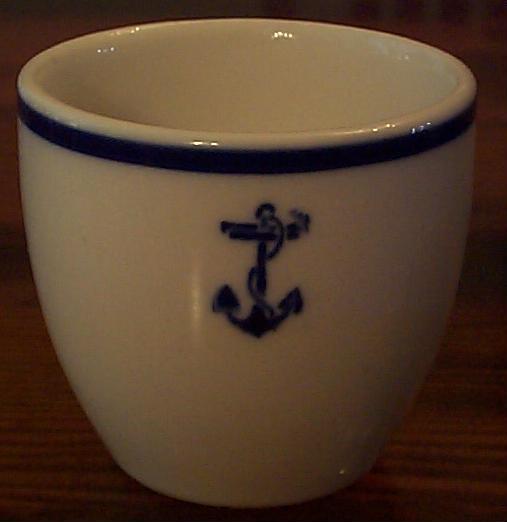
The two photo's above represent the two different fouled anchors the US Navy used as topmarks for the Wardroom Officer's Mess from the early 1900's to 1970's. The older gold fouled anchor topmark on the left was used from about 1900 through 1940. The newer blue anchor topmark on the right was used from about 1940 through 1970's.
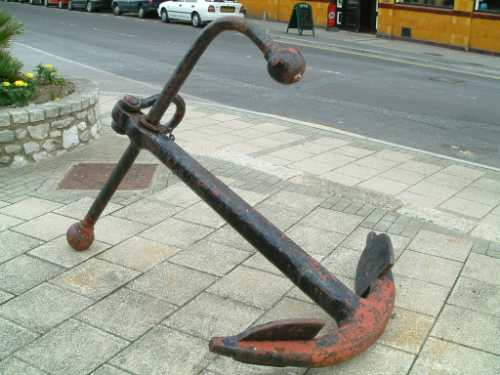

The older "Twisted Arm Anchor" allowed the arm to be movable so that the anchor could be hauled up into the anchor hawser and secured when not in use. The fixed arm anchor would not allow it to be hauled up into a hawser for storage. The US Navy used both types of anchors. Both anchor types were used in the late 1800's to early 1900's.
The 3rd photo to the right shows some sailors inspecting a twisted arm anchor aboard a ship taken during Spanish-American War to WWI timeframe.
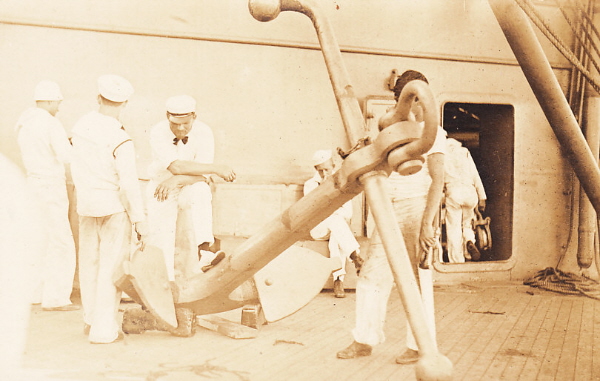
So far it appears that from the early 1900's through to WWII the US Navy used 2 basic topmarks for its official Naval china: the Gold Fouled Anchor and the Department of the Navy Seal. The Navy Seal itself was further differentiated by having 2, 3 or 4 Stars each denoting Admiral Rank.
Note the very intricate, detailed, and elegant design of the older golden fluked anchor with twisted steel stock which was used on the older 1894/1898 topmarks and early 1905-1939 Dept of Navy topmark! One can clearly see the links in the anchor chain. Properly producing this older topmark certainly took more time, skill and money, but it is certainly quite elegant and beautiful. The newer blue fouled anchor represented the Navy's change in it's official fouled anchor insiginia and was demonstrably plainer and less detailed. While nice, this new blue fouled anchor topmark could not compare with the older one.
It is unclear and so far undocumented if the Navy prior to WWII used different topmarks other than the Gold Anchor and Dept of Navy Seal. During WWII the Navy designed specific topmarks for the Warrant Officer's, Junior Officer's, Wardroom Officer's, Captains, Rear/Vice/Full Admirals and the Department of the Navy,
Click Here to Review Official US Navy China and the Topmarks used for specific Naval Officer Rank.
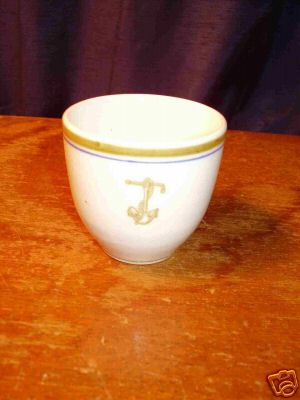
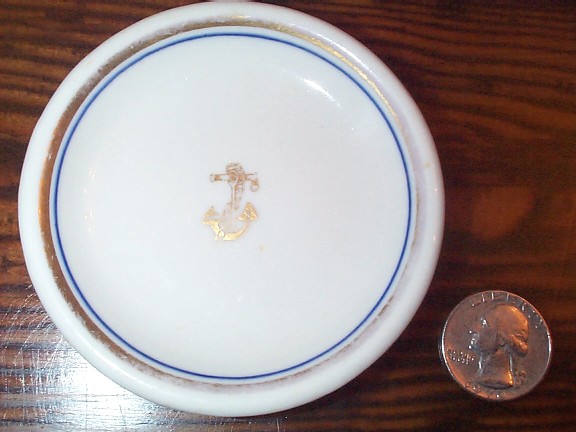
The above demitasse cup and butter pat plate clearly illustrate the original Wardroom Officer's Mess topmark of the gold Fluked Fouled Anchor Insignia. The anchor presented is properly called a "naval fluked fouled anchor with twisted steel stock with chain fouling the anchor", and was used from the very early 1900's through 1940 in the Wardroom Officer's Mess and most likely in the Captain's Mess as well.
Worthy to note, each type of fluked anchor design was also incorporated into the Department of the Navy Seal of the same era.
The Pirate's Lair has various china pieces using the above old anchor topmark with dates of 1933, 1935 and 1939 produced from a number of different china manufacturer's.
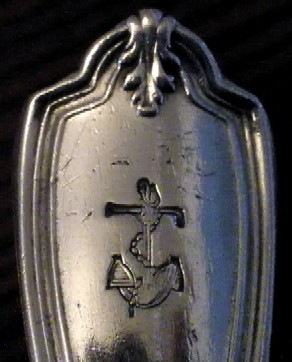

Above photographs illustrate one of the earliest uses of the traditional US Navy Fouled Anchor with Twisted Arm on Silverware! This piece was produced by the International Silver Co in the New Grecian or Grecian Pattern with a production date of 1913.
This surviving dinner fork was part of a larger set because we have a pair of tongs in the same pattern using the exact same fouled anchor monogram. This fouled anchor monogram also matches perfectly with the above gold fouled anchors on the china pieces.
Yes, we know that the King's Design was patented and used from the 1880's, and we know that the US Navy standardized on using this pattern with a fouled anchor at some time, but we have no hard evidence when this occured. Until we can find the hard evidence when the Navy began using the King's design with the fouled anchor this dinner fork is the earliest documented silverware with the fouled anchor.
| WWII US Navy China by Officer Rank Insignia Topmark |
 Click Photo for Close Up View! |
|
Shows USN-Warrant Officer, Squareknot-Junior Officer, Fouled Anchor-Wardroom Officer, Burgee Pennant-Captain, 2 Star, 3 Star and 4 Star-Admirals | |
| |
 Click Photo For Close Up View! |
|
|
|
| The Real Deal! Fully Restored Antique Trunks Like Sea Chests, Pirate Chests, Treasure Chests - Perfect as a Naval Retirement Gift, use as a Shadowbox and to store Uniforms and Service Memorabilia! |
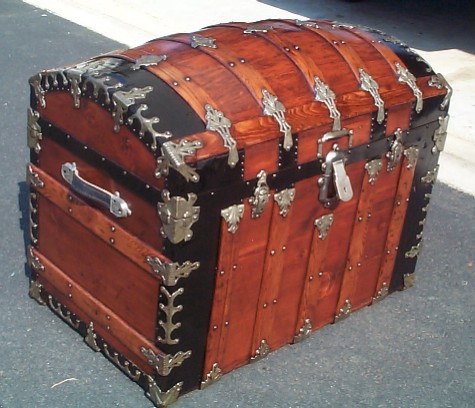 Click Here To Review Sample Engravings |
|
| Custom Designed, Handcrafted, and Hand Lettered in Caligraphy on your Antique Chest |
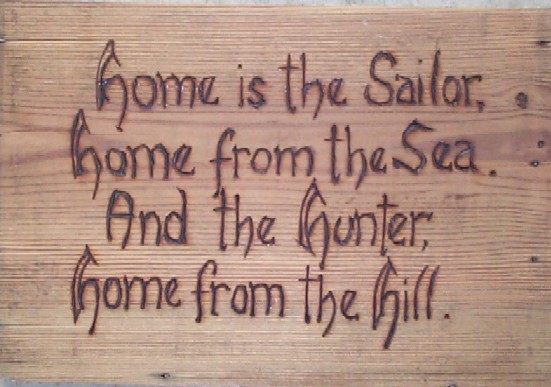 Click Here To Review Sample Engravings |
|
| Customer Photographic Examples of our Antique Trunks Being used as a Military or Naval Retirement Shadow Box and Storage Chest!! |
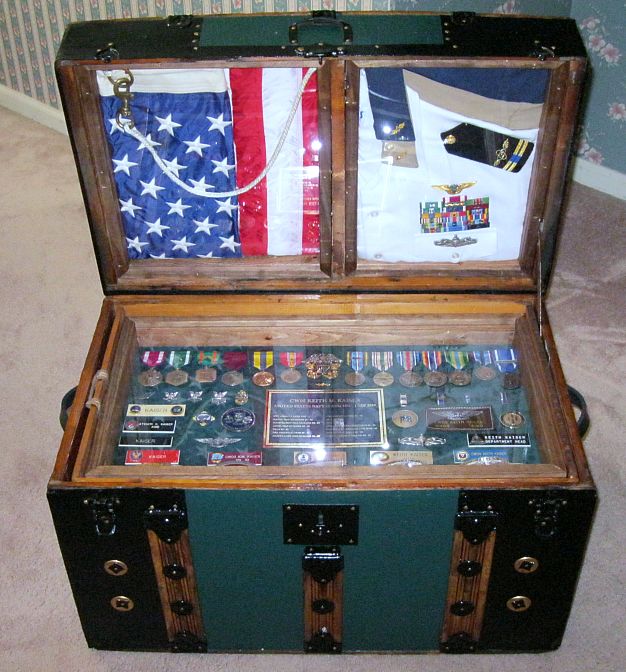 Click Here for Sample Shadow Box Photographs From Customers |
|